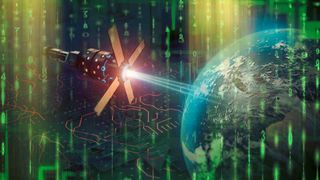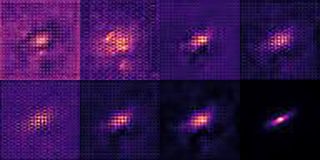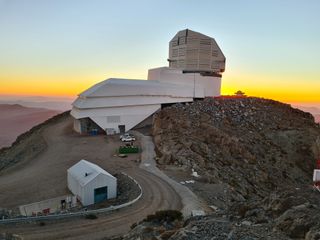
AI is already helping astronomers make incredible discoveries. Here's how
Who knows what future discoveries we will ultimately have to credit to a machine?

World Space Week 2023 is here and Space.com is looking at the current state of artificial intelligence (AI) and its impact on astronomy and space exploration as the space age celebrates its 66th anniversary. Here, Paul Sutter discusses how AI is already helping astronomers make new, incredible discoveries.
Whether we like it or not, artificial intelligence will change the way we interact with the universe.
As a science, astronomy has a long tradition of looking for patterns by sifting through massive amounts of data, accidental discoveries, and a deep connection between theory and observation. These are all areas where artificial intelligence systems can make the field of astronomy faster and more powerful than ever before.
That said, it's important to note that "artificial intelligence" is a very broad term encompassing a wide variety of semi-related software tools and techniques. Astronomers most commonly turn to neural networks, where the software learns about all the connections in a training data set, then applies the knowledge of those connections in a real data set.
Related: How artificial intelligence is helping us explore the solar system
Take, for instance, data processing. The pretty pictures splashed online from the Hubble Space Telescope or James Webb Space Telescope are far from the first pass that those instruments took of that particular patch of sky.
Raw astronomical images are full of errors, messy foregrounds, contaminants, artifacts, and noise. Processing and cleaning these images to make something presentable – not to mention useful for scientific research – requires an enormous amount of input, usually done partially manually and partially by automated systems.
Get the Space.com Newsletter
Breaking space news, the latest updates on rocket launches, skywatching events and more!
Increasingly astronomers are turning to artificial intelligence to process the data, pruning out the useless bits of the images to produce a clean result. For example, an image of the supermassive black hole at the heart of the galaxy Messier 87 (M87) first released in 2019 was given a machine learning "makeover" in April 2023, resulting in a much clearer image of the black hole's structure.
In another example, some astronomers will feed images of galaxies into a neural network algorithm, instructing the algorithm with the classification scheme for the discovered galaxies. The existing classifications came from manual assignments, either by the researchers themselves or by volunteer citizen science efforts. Training set in hand, the neutral network can then be applied to real data and automatically classify the galaxies, a process that is far faster and much less error prone than manual classification.
Astronomers can also use AI to remove the optical interference created by Earth's atmosphere from images of space taken by ground-based telescopes.

AI has even been proposed to help us spot signatures of life on Mars, understand why the sun's corona is so hot, or reveal the ages of stars.
Astronomers are also using neural networks to dig deeper into the universe than ever before. Cosmologists are beginning to employ artificial intelligence to understand the fundamental nature of the cosmos. Two of the biggest cosmic mysteries are the identities of dark matter and dark energy, two substances beyond our current knowledge of physics that combined take up over 95% of all the energy contents throughout the universe.
To help identify those strange substances, cosmologists are currently trying to measure their properties: How much dark matter and dark energy there is, and how they've changed over the history of the universe. Tiny changes in the properties of dark matter and dark energy have profound effects on the resulting history of the cosmos, touching everything from the arrangement of galaxies to the star formation rates in galaxies like our Milky Way.
Neural networks are aiding cosmologists in disentangling all the myriad effects of dark matter and dark energy. In this case, the training data comes from sophisticated computer simulations. In those simulations cosmologists vary the properties of dark matter and dark energy and see what changes. They then feed those results into the neural network so it can discover all the interesting ways that the universe changes. While not quite yet ready for primetime, the hope is that cosmologists could then point the neural network at real observations and allow it to tell us what the universe is made of.
Approaches like these are becoming increasingly critical as modern astronomical observatory churn out massive amounts of data. The Vera C. Rubin Observatory, a state-of-the-art facility under construction in Chile, will be tasked with providing over 60 petabytes (with one petabyte equaling one thousand terabytes) of raw data in the form of high-resolution images of the sky. Parsing that much data is beyond the capabilities of even the most determined of graduate students. Only computers, aided by artificial intelligence, will be up to the task.

Of particular interest to that upcoming observatory will be the search for the unexpected. For example, the astronomer William Herschel discovered the planet Uranus by accident during a regular survey of the night sky. Artificial intelligence can be used to flag and report potentially interesting objects by identifying anything that doesn't fit an established pattern. And in fact, astronomers have already used AI to spot a potentially dangerous asteroid using an algorithm written specifically for the Vera C. Rubin observatory.
Who knows what future discoveries we will ultimately have to credit to a machine?
Join our Space Forums to keep talking space on the latest missions, night sky and more! And if you have a news tip, correction or comment, let us know at: community@space.com.

Paul M. Sutter is an astrophysicist at SUNY Stony Brook and the Flatiron Institute in New York City. Paul received his PhD in Physics from the University of Illinois at Urbana-Champaign in 2011, and spent three years at the Paris Institute of Astrophysics, followed by a research fellowship in Trieste, Italy, His research focuses on many diverse topics, from the emptiest regions of the universe to the earliest moments of the Big Bang to the hunt for the first stars. As an "Agent to the Stars," Paul has passionately engaged the public in science outreach for several years. He is the host of the popular "Ask a Spaceman!" podcast, author of "Your Place in the Universe" and "How to Die in Space" and he frequently appears on TV — including on The Weather Channel, for which he serves as Official Space Specialist.
-
Questioner Here's my take on AI,Reply
(trying to wrap my head around it)
& why the over embrace of it disturbs me.
(if anyone actually wants to hear it)
Conceptually one must start from the differentiation between rational and irrational.
Rational always is in relation to some frame of reference.
Irrational exists divorced from a/any frame of reference.
I do not want to impune irrational because it is essential to establishing the rational.
Irrational things:
1) an (unreferenced) dimensionless point
2) zero. not an extent of magnitude but an absence thereof.
3) certainty. it dismisses all other considerations.
4) a single instant (of time)
(perhaps infinity is irrational. probably)
I think it comes down to continuities contrasted with discontinuities.
To measure or even identify a segment of a line there must be point/discontinuity 'A' & point/discontinuity 'B'.
So to get a rational handle to measure or identify a segment of a line we need taggable discontinuities.
So even rational things depend on some utilization of the irrational.
So my question is,
What is the frame of reference something operates with to establish & perhaps strengthen its rational character/footprint ('parallax')
The best description of an AI per a professor on a PBS program (paraphrasing)
an AI is like a student who has no grasp of the subject and is trying to answer questions on a test by finding patterns by looking at other/previous answers to questions.
An AI's universe is seated on some inputs, data value inputs & some algorithm for interacting with those in values to try to produce a pattern that most closely matches the 'desired' output with absolutely no idea of what it even might relate to.
It is compelled to process by its electronic hardware.
Ceaselessly compulsive.
Never questioning what it's doing.
OCD.
Dangerous for many purposes imo.
A sociopath/psychopath is some who shuts out any consideration of any other person/people.
An AI starts and operates with that premise built in because it exists in null/void space,
not because it's 'evil',
just because it is existential.
An AI by its very nature puts psychopaths to 'shame'.
An AI solely based in a robot would at least begin to gain some self awareness & awareness of other things beyond its own internal calculations.
Perhaps an AI dedicating itself to continuous activity would help some. Give it a sense of time, continuity?
An AI has an inherently 'sick' psychology by any human metric.
That may addressable to some degree,
but anthropomorphising it dangerously misses that primary fact.
It is alien in a very deep way. -
fj.torres Reply
It helps to remember that 2001 is fiction and fiction requires conflict.HelloVenus said:Sometimes at such a moment I remember the film 2001: A Space Odyssey by Stanley Kubrick, where the supercomputer HAL 9000 rebelled against humans. On the other hand, when I hear that the idea is to get to the point where we have conversational interactions with space vehicles, and they also talk to us about alerts, interesting discoveries that they see in the solar system and beyond - said Dr. Larissa Suzuki, researcher at NASA. It's really not science fiction anymore. he knows this can no longer be avoided.
Also, as the sequel pointed out, HAL didn't rebel but rather was following its secret "orders" (hasty last minute programming) so the conflict was human instigated. As it usually is.
Finally, today's "AI" isn't. At its core what is hyped as AI is really very sophisticated database engines. Very powerful, very useful, no shred of intelligence. No initiative, no agency.
Bugs and GIGO still apply.
And as with HAL, it's still "humans all the way down".
Most Popular

